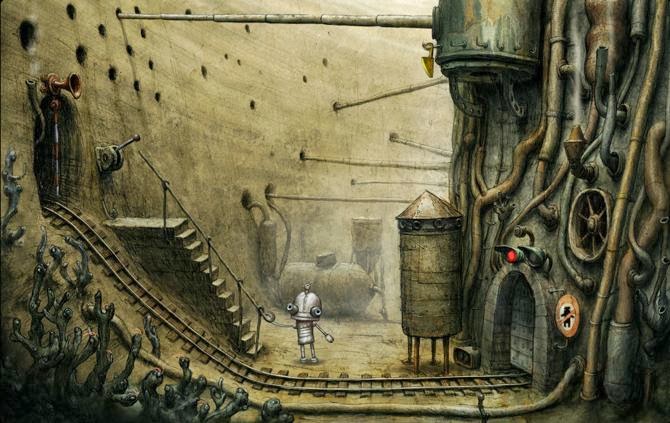One of my favorite pastimes growing up
was playing through Sierra adventure games again and again and again.
I used to run laps around the fictional Kingdom of Daventry and its
neighboring realms, playing speed runs that weren't really speed runs
in the early King's Quest
games. I had even more fun ripping through time and space as Roger
Wilco in the satirical Space Quest adventures.
Back then, it wasn't so much the challenge of the game that drew me
in—I'd memorized the solutions to all of the so-called puzzles like
the lines of dialogue in a movie. It was fun just going through the
motions, triggering the animation sequences and sometimes having fun
experimenting with all of the goofy ways to lose or die.
So
it's interesting to return to the genre in the present day—even for
a title as distinct as Machinarium.
Unlike
the Sierra and LucasArts games of the past, Machinarium
tells its story without text or exposition. Characters communicate
with body language and illustrated thought bubbles. The protagonist
is a down-on-his-luck robot, who finds himself cast out from a
towering robot enclave by a band of unsavory robot thugs. After
sneaking back into the city and succumbing to further gaffes and
blunders, the player must uncover and thwart a nefarious plot against
the denizens of the city.
The story and style of Machinarium actually reminds me of the silent movie era—particularly the American
comedies of Charlie Chaplin, Buster Keaton, etc. I have no idea
whether the influence is direct or intentional, but the plight of the
protagonist does bear some thematic resemblance to that of Chaplin's
tramp. The robot, while plucky and persistent, is clearly on the
margins of this cold-hearted, industrial society, forced to navigate his many setbacks through impromptu tricks and disguises.
Those
are the things I liked about Machinarium.
What I didn't always like was how the game actually played as a
puzzle-solving exercise.
It
seems to me that the game's puzzles tend to fall into one of two
camps. First are the environmental puzzles, the ones that involve
finding clickable objects and inventory items to use and manipulate.
These are the types of puzzles we typically associate with the
classic adventure games genre. The second suite of puzzles were more
like logic mini-games and brainteasers. Surprisingly, I enjoyed the
latter much more than the former. The traditional puzzles rarely make
logical or predictive sense, which means the player will resort to
brute-force tactics—clicking the mouse cursor all over the screen
in hopes of triggering some sort of interaction. In adventure game
terminology, we call this activity “pixel hunting.” It's all the
more frustrating in Machinarium,
because the player is further restricted from interacting with
anything outside of a short radius of the character avatar.
Part
of the problem is the lack of visual cues. At one point in the game I
had solved a pretty challenging mini-game puzzle, which—in my
mind—should have progressed a related environmental puzzle.
Unfortunately, I hadn't noticed a small button on a panel, because
there was nothing that differentiated that button from being anything
other than a simple screw, rivet, or any other pencil-textured circle
in the homogenous background environment.
With
Machinarium, the
developers must have foreseen this, because they implemented their
own in-game hint and cheat system. For most locations in the game,
the player can click on a lightbulb icon that offers a quick hint.
Nine times out of 10, these hints are useless. In that case, the
player can click on a book icon that enacts a strange side-scrolling
arcade game. By winning the game, the player will gain access to a
page that shows a visual representation of the solutions to that particular game screen's puzzles.
At first I hated
the very thought of this. But let me tell you, it was necessary to
go back to that cheat system more than once. And I guess if it's right there
in the game, it's not technically cheating, is it?
By the time I made it to the end of the short game, I was happy that I'd stuck with it. And I'm definitely interested to check out some other games (newer and older) from Czech developer Amanita Design. Based on this title alone, however, I would have to say they are much better at animation and illustration than game design.
By the time I made it to the end of the short game, I was happy that I'd stuck with it. And I'm definitely interested to check out some other games (newer and older) from Czech developer Amanita Design. Based on this title alone, however, I would have to say they are much better at animation and illustration than game design.


